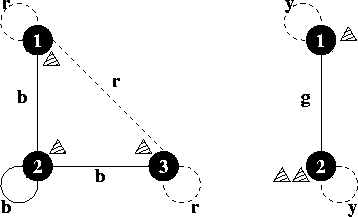Description
"Hike on a Graph" is a game that is played on a board on which an undirected graph is drawn. The graph is complete and has all loops, i.e. for any two locations there is exactly one arrow between them. The arrows are coloured. There are three players, and each of them has a piece. At the beginning of the game, the three pieces are in fixed locations on the graph. In turn, the players may do a move. A move consists of moving one's own piece along an arrow to a new location on the board. The following constraint is imposed on this: the piece may only be moved along arrows of the same colour as the arrow between the two opponents' pieces.
In the sixties ("make love not war") a one-person variant of the game emerged. In this variant one person moves all the three pieces, not necessarily one after the other, but of course only one at a time. Goal of this game is to get all pieces onto the same location, using as few moves as possible. Find out the smallest number of moves that is necessary to get all three pieces onto the same location, for a given board layout and starting positions.
In the sixties ("make love not war") a one-person variant of the game emerged. In this variant one person moves all the three pieces, not necessarily one after the other, but of course only one at a time. Goal of this game is to get all pieces onto the same location, using as few moves as possible. Find out the smallest number of moves that is necessary to get all three pieces onto the same location, for a given board layout and starting positions.
Input
The
input contains several test cases. Each test case starts with the
number n. Input is terminated by n=0. Otherwise, 1<=n<=50. Then
follow three integers p1, p2, p3 with 1<=pi<=n denoting the
starting locations of the game pieces. The colours of the arrows are
given next as a m×m matrix of whitespace-separated lower-case letters.
The element mij denotes the colour of the arrow between the locations i
and j. Since the graph is undirected, you can assume the matrix to be
symmetrical.
Output
 For
each test case output on a single line the minimum number of moves
required to get all three pieces onto the same location, or the word
"impossible" if that is not possible for the given board and starting
locations.
For
each test case output on a single line the minimum number of moves
required to get all three pieces onto the same location, or the word
"impossible" if that is not possible for the given board and starting
locations. Sample Input
3 1 2 3 r b r b b b r b r 2 1 2 2 y g g y 0
Sample Output
2 impossible
题目大意:一张完全图,三个人,图的边上有颜色,三个人的位置已知,每次只能让一个人移动一次,求总共最少移动多少次,三个人能碰面。移动的规则是:当前人要走的边的颜色与其他两个人之间的边的颜色相同时,才能移动。
题目分析:大水题!!!wa了几次都是因为没有搞懂移动规则,把这道题记下来给自己涨个记性!!!
代码如下:
1 # include<iostream> 2 # include<cstdio> 3 # include<queue> 4 # include<cstring> 5 # include<algorithm> 6 using namespace std; 7 struct node 8 { 9 int a,b,c,t; 10 node(int _a,int _b,int _c,int _t):a(_a),b(_b),c(_c),t(_t){} 11 bool operator < (const node &a) const { 12 return t>a.t; 13 } 14 }; 15 int n,vis[60][60][60]; 16 char p[60][60]; 17 void bfs(int a,int b,int c) 18 { 19 priority_queue<node>q; 20 memset(vis,0,sizeof(vis)); 21 vis[a][b][c]=1; 22 q.push(node(a,b,c,0)); 23 while(!q.empty()) 24 { 25 node u=q.top(); 26 q.pop(); 27 if(u.a==u.b&&u.b==u.c&&u.a==u.c){ 28 printf("%d ",u.t); 29 return ; 30 } 31 for(int i=1;i<=n;++i){ 32 if(p[u.a][i]==p[u.b][u.c]&&!vis[i][u.b][u.c]){ 33 vis[i][u.b][u.c]=1; 34 q.push(node(i,u.b,u.c,u.t+1)); 35 } 36 } 37 for(int i=1;i<=n;++i){ 38 if(p[u.b][i]==p[u.a][u.c]&&!vis[u.a][i][u.c]){ 39 vis[u.a][i][u.c]=1; 40 q.push(node(u.a,i,u.c,u.t+1)); 41 } 42 } 43 for(int i=1;i<=n;++i){ 44 if(p[u.c][i]==p[u.a][u.b]&&!vis[u.a][u.b][i]){ 45 vis[u.a][u.b][i]=1; 46 q.push(node(u.a,u.b,i,u.t+1)); 47 } 48 } 49 } 50 printf("impossible "); 51 } 52 int main() 53 { 54 int a,b,c; 55 while(scanf("%d",&n)&&n) 56 { 57 scanf("%d%d%d",&a,&b,&c); 58 for(int i=1;i<=n;++i) 59 for(int j=1;j<=n;++j) 60 cin>>p[i][j]; 61 bfs(a,b,c); 62 } 63 return 0; 64 }